Crucial MX500 SSD Review: Challenging Samsung on SATA
Why you can trust Tom's Hardware
Comparison Products
512GB is the new 256! With the NAND shortage behind us, pricing can resume its downward slope. Now higher-capacity models are replacing smaller products at each price point. The 500GB MX500 retails for just $140. It wasn't very long ago that $140 was the entry-level cost of a high-quality 256GB-class SSD. This capacity delivers excellent value, but there is more to the story. Many new SSDs don't reach full performance in capacities smaller than 512GB because of the 256GBit die, but this capacity hits the sweet spot.
The BX300 is the underling from Crucial's current lineup. The drive features first-generation 3D MLC flash, but it's not the only MLC model in the charts. The Corsair Neutron XTi is the only Phison S10 drive in our tests with Toshiba's 15nm MLC. The Intel 545s, SanDisk Ultra 3D, Samsung 850 and 860 EVO all use 3D TLC NAND.
Sequential Read Performance
To read about our storage tests in-depth, please check out How We Test HDDs And SSDs. We cover four-corner testing on page six of our How We Test guide.


The 512GB-class products are very close in sequential performance like the 1TB drives. There is enough NAND parallelization inside these products to push the limits of the SATA interface.
Sequential Write Performance


There is a little more variation when we write data to the drives, but these products all deliver exceptional sequential write performance at low queue depths. You won't notice much of a difference simply transferring files to and from the drives.
Random Read Performance



Random read performance is the most important synthetic measurement. Windows constantly reads small 4KB files in the background, so stronger 4KB random performance leads to a better user experience.
The Crucial MX500 delivers the highest random read performance at low queue depths we've measured with our new burst testing. The 500GB model is actually faster than many low-cost NVMe SSDs on the market with first generation 3D flash.
Get Tom's Hardware's best news and in-depth reviews, straight to your inbox.
Random Write Performance



The 500GB MX500 falls in the middle of the chart. The MX500's SLC cache is large enough to absorb the random data writes, which reduces the value of this test somewhat. Strong performance here is almost a given as modern consumer SSDs have largely moved beyond random writes as a bottleneck for consumer workloads.
70% Mixed Sequential Workload
We describe our mixed workload testing in detail here and describe our steady state tests here.


You'll notice lower performance with mixed read/write workloads compared to the 100% read or write tests. A few years ago some products would lose around 50% of their performance in this test. SSD controllers have evolved with more cores and better programming, though. Many of the most popular products deliver roughly the same performance with mixed sequential data. The MX500 is right in the mix with the best products on the market.
70% Mixed Random Workload


Mixed random data is more of a concern when you're shopping for a new SSD. This type of workload also impacts the user experience and is even more important than the 100% random read test. That's because your operating system updates file metadata (a write operation) right after it reads the data.
The MX500 dominates the QD2 test and maintains a strong lead in the QD4 test. The 850 EVO overtakes the MX500 at QD4, but by then we're outside of what most users will see when they are multitasking.
Sequential Steady-State

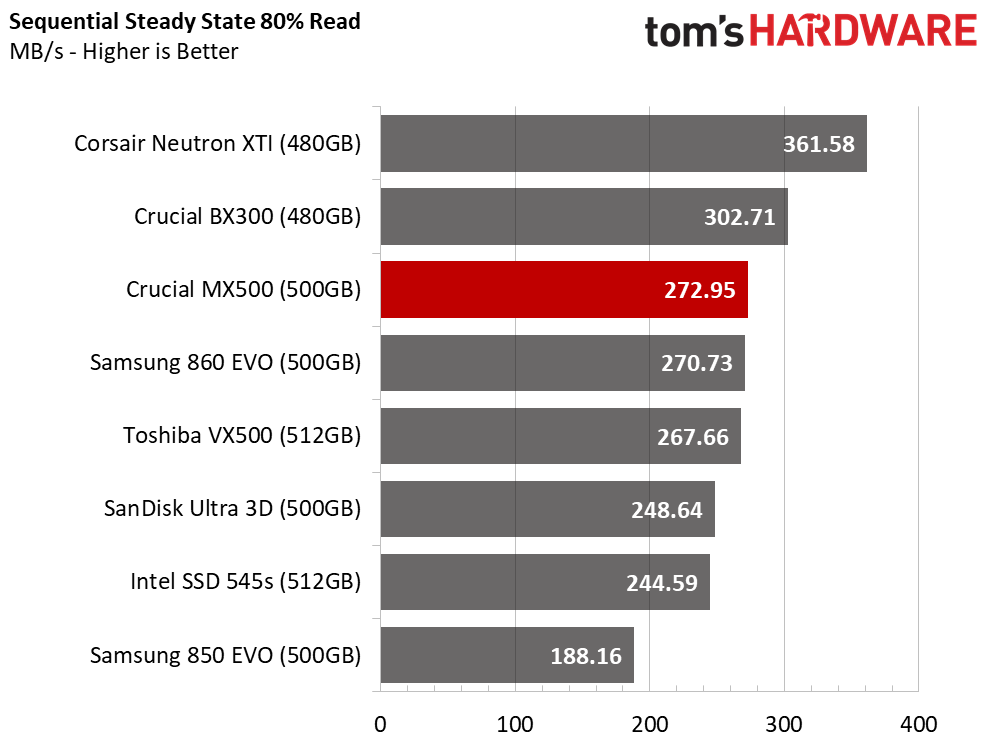

Steady-state performance comes during and after very heavy write workloads. Most users don't stress their storage in this way, but some consumer SSDs are fast enough for this type of workload. The Corsair Neutron XTi with an eight-core Phison controller and all eight channels populated shows how purpose-built drives can perform well under these conditions.
The Neutron XTi stands out in this test. It's one of the few products still shipping with MLC flash. The MX500 and most of the other products in the charts use TLC flash. We see those products clustered together without a real standout. The low endurance ratings would keep us from using most of these products frequently with a heavy write workload.
Random Steady-State

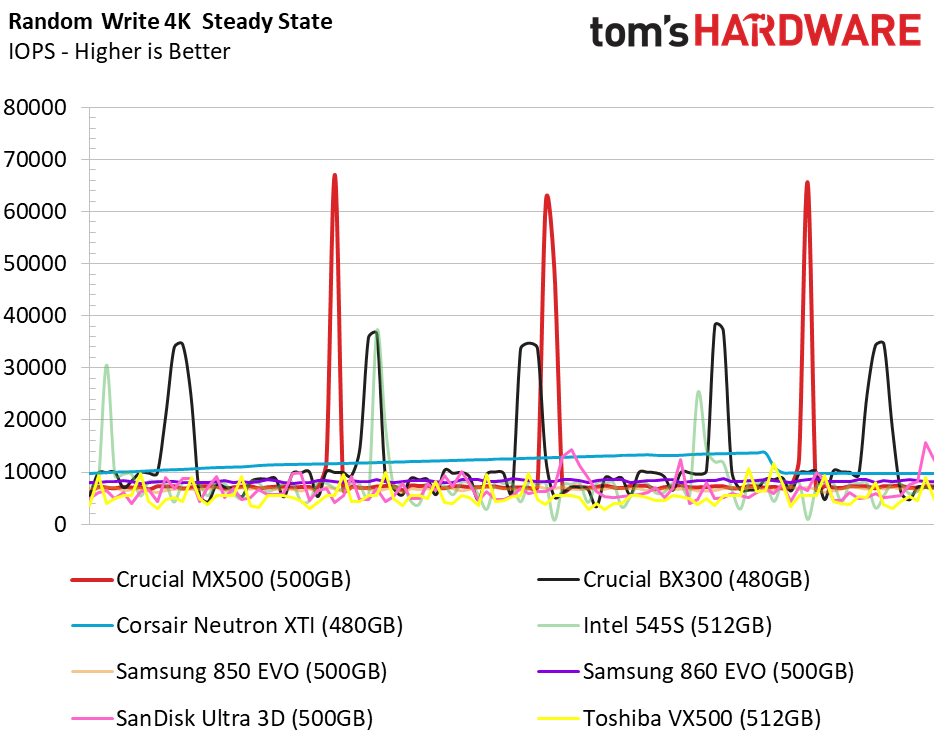

The random write steady-state tests shows us the lowest possible performance. Here we look for two traits: high write performance and consistency. A consistent SSD delivers predictable performance in a RAID array.
The MX500 500GB doesn't suffer from large performance drops, but the test shows significant peaks from the cache. We wouldn't shy away from using this drive in a consumer RAID 0 array. It's a good way to increase sequential performance and storage capacity.
PCMark 8 Real-World Software Performance
For details on our real-world software performance testing, please click here.







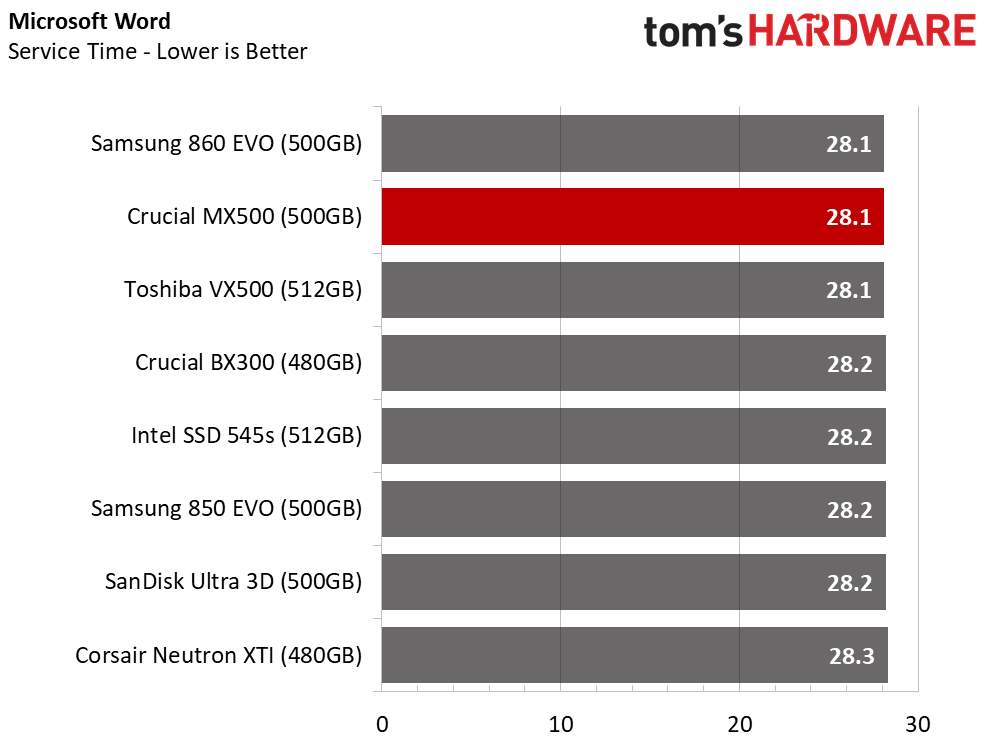


There are not any surprises in our application tests with real-world software. The MX500 doesn't overpower the other drives but is in the mix with the best SATA SSDs on the market.
Application Storage Bandwidth
The drives separate into two tiers, but all of the drives are exceptional for consumer workloads. Mechanical hard disk drives only score between 20 and 30 MB/s, and that's with the latest high-capacity models that cost three times more than the drives we're testing.
PCMark 8 Advanced Workload Performance
To learn how we test advanced workload performance, please click here.



We see the 500GB MX500's weakness as it recovers from a heavy workload. The 2TB model also had throughput issues during this portion of the test, but the service time and latency hold steady.
Total Service Time



The 500GB MX500 struggles as it recovers from a heavy workload. On the one hand, we don't like to see this behavior, but on the other, this is just the world we live in with 256Gbit TLC NAND.
Disk Busy Time
The MX500 500GB doesn't have any trouble with disk busy time. The Intel 545s and OCZ VX500 both had issues completing the application tasks, but the other products all provide expected results.
BAPCo SYSmark 2014 SE Responsiveness Test
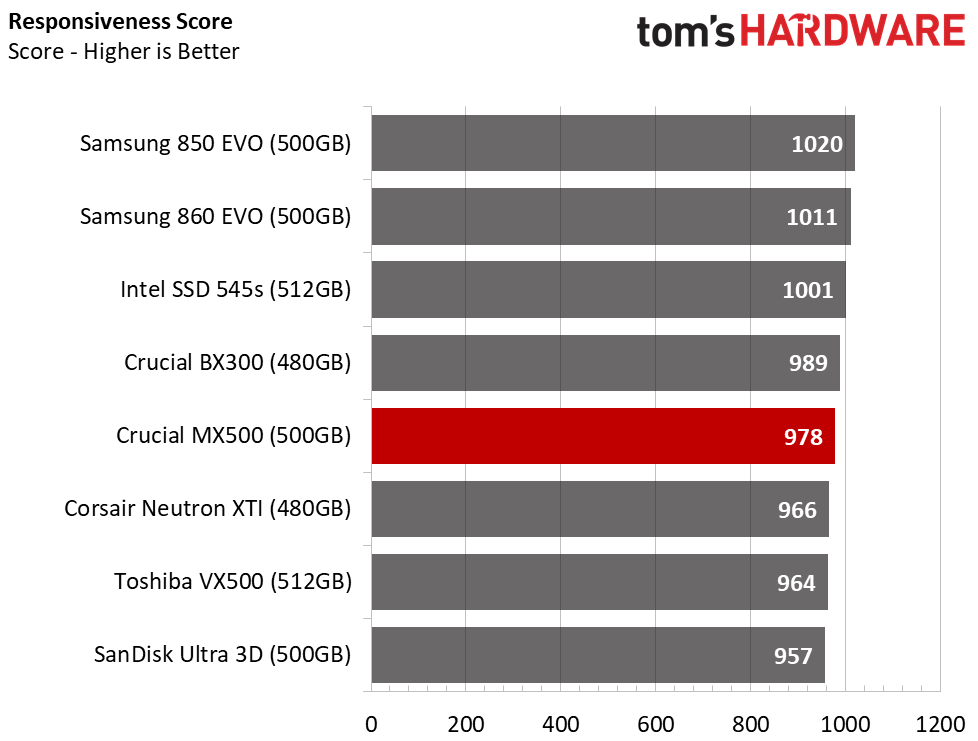

We begin to see the pattern of lower performance with smaller drives. We expect this trend, but it is largely hidden from specification sheets. The 500GB MX500 is less responsive than the 2TB and 1TB drives. This model still performs well, but the new Samsung 860 and older 850 EVO SSDs armed with Samsung's fully mature V-NAND don't lose as much performance in smaller capacities.
BAPCo MobileMark 2012.5 Notebook Battery Life
To learn how we test advanced workload performance, please click here.

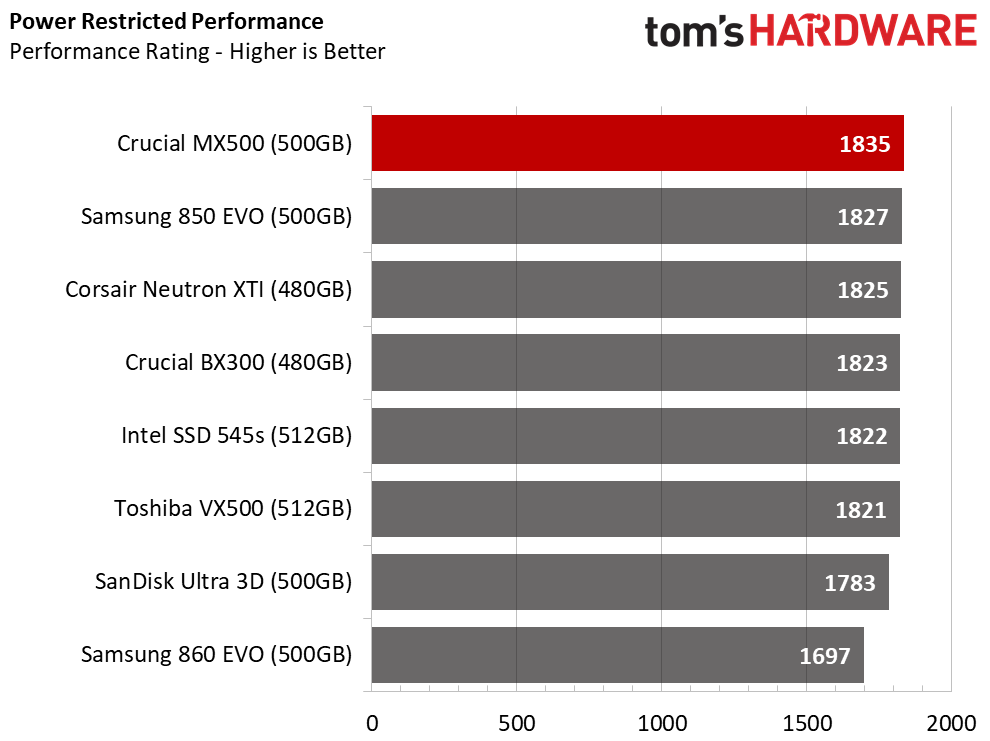
The MX500 500GB delivered 353 minutes of battery life in our Lenovo Y700-17 gaming notebook. The result is good, but not exemplary. The drive compares well to the Samsung 850 EVO and is better than the new 860 EVO with the initial retail firmware.
MORE: Best SSDs
MORE: How We Test HDDs And SSDs
MORE: All SSD Content
Current page: 512GB Performance Results
Prev Page 1TB Performance Results Next Page 256GB Performance Results
Chris Ramseyer was a senior contributing editor for Tom's Hardware. He tested and reviewed consumer storage.
-
HERETIC-1 Hi Chris,Reply
That 4K read at QD1 is impressive.
Am holding my praise until I see the 250 size tho........... -
unityole 2TB for $520? not bad at all for a TLC drive, especially one at this performance level considered to be better than the best in industry. nice review Chris! can't wait for a 4TB of this drive out for less than $800 though.Reply -
bit_user Reply
Glad to see this. The MX300 was such a let down, performance-wise, and I'm eager to see prices drop in the 1 TB size.20498199 said:...
Do they still advertise end-to-end data protection? The Crucial MX-line has tended to be one of the more reliable options, and I hope that doesn't change. It's one of the main reasons I've never been tempted by Samsung. I have 9 Crucial SSDs and no failures (yet).
Did they ever explain what happened to the MX400? Maybe a product that got cancelled?
Also, I wonder how much DRAM it's got. -
bit_user Reply
Truly. I always figured Samsung has got to be close to what SATA can deliver. I didn't expect anyone to provide such an improvement, much less for Crucial to take the lead.20498288 said:That 4K read at QD1 is impressive.
-
bit_user Partially answered my question about data protection. They don't advertise "end-to-end data protection", as before, but I recognize a number of features carried over from the MX200:Reply
• Redundant Array of Independent NAND (RAIN)
• Exclusive Data Defense
• Error Correction Code (ECC)
Of course, all SSDs have some sort of ECC. However, the MX200 advertised what they call "Data Path Protection", while the MX500 lists "Multistep Data Integrity Algorithm". So, I'm still wondering if these are comparable.
Here are the datasheets I could find:
http://www.crucial.com/wcsstore/CrucialSAS/pdf/product-flyer/crucial-mx200-ssd-product-flyer-letter-en.pdf
http://www.crucial.com/wcsstore/CrucialSAS/pdf/product-flyer/crucial-mx500-ssd-productflyer-en.pdf -
TripleHeinz Similar to bit_user, I have crucial/micron for all my memory needs: From storage to RAM. I went with this brand 4 years ago and their products have never let me down. The reason I went with crucial/micron is because at the time of purchasing they were the only brand offering enterprise class solutions for workstations where data integrity, privacy and safe storage are critical. Their products had all kind of ecc and data integrity technologies, encryption of all kinds (providing whitepapers to teach how to implement them) and power loss safety through super caps which allow data to flush from cache even on power loss (you can safely disable "write-caching buffer flushing" in Windows for better performance). You can install Storage Executive for monitoring but you should not enable "momentum cache" because if I'm not mistaken you could lose your data on power outage.Reply
I understand that now Samsung has most of these features in their products, but I can't simply go away from a brand that I trust and have been working with their products for years now with success. The SSDs have been working perfectly, they feel pretty fast too, I love them. They still report 100% life, can't explain that. I'm a satisfied customer and can recommend crucial/micron for workstations. -
bit_user Reply
Yeah, I don't bother with it. The OS should do write buffering, and I see Momentum Cache as basically a Band-Aid over Windows' deficiencies.20499336 said:You can install Storage Executive for monitoring but you should not enable "momentum cache" because if I'm not mistaken you could lose your data on power outage.
But the biggest worry I have about system crashes is actually filesystem corruption, and there Momentum Cache has a lot more potential to harm than help.
Anyway, use a UPS to mitigate against power loss. Now that PCs and monitors are so power-efficient, you can get by with a much cheaper unit than before. I have a nice PFC-compatible CyberPower that was < $100, IIRC.
Really? I've not seen that, and I had been checking until fairly recently.20499336 said:I understand that now Samsung has most of these features in their products,
Also, note that Crucial's BX line lacks many of the reliability features found in the MX line.
The main thing for me is the user reviews. At least up through MX200, Crucial was rated highest. I didn't bother checking MX300, however.20499336 said:I can't simply go away from a brand that I trust and have been working with their products for years now with success.
A co-worker recently mentioned two Crucial SSD drive failures among his family members. He didn't say which model, but I wonder if they were BX drives. -
JimmiG "CONSReply
The look appears dated"
Yeah, not a single RGB LED. Unacceptable.
Seriously though it's good to see the race to the bottom in consumer SATA SSD's seems to have reached an end. This drive from 2017 even manages to beat the 2014 Samsung 850 Evo in a few tests. -
CRamseyer You have to remember that we see every Crucial drive and the packaging hasn't changed much over the years.Reply
I also had to think of something to fill in the space. That's the only part about the drive that I would improve if I was the product manager....and make a 4TB version.




